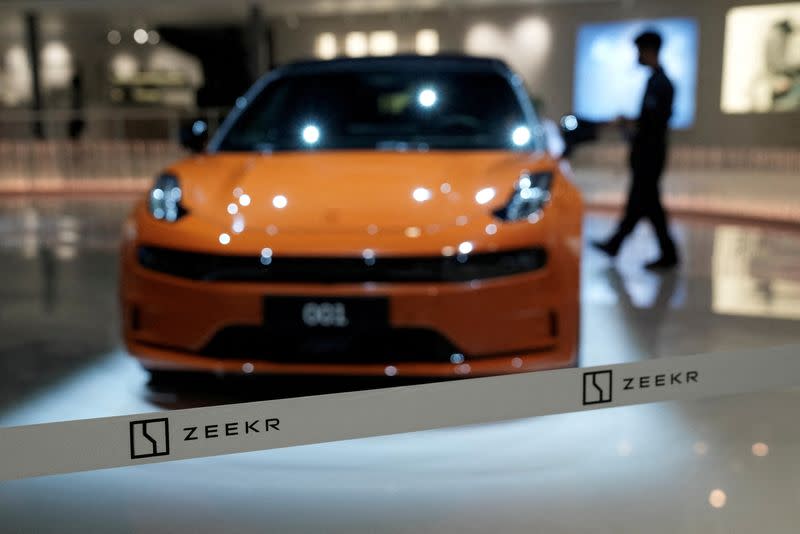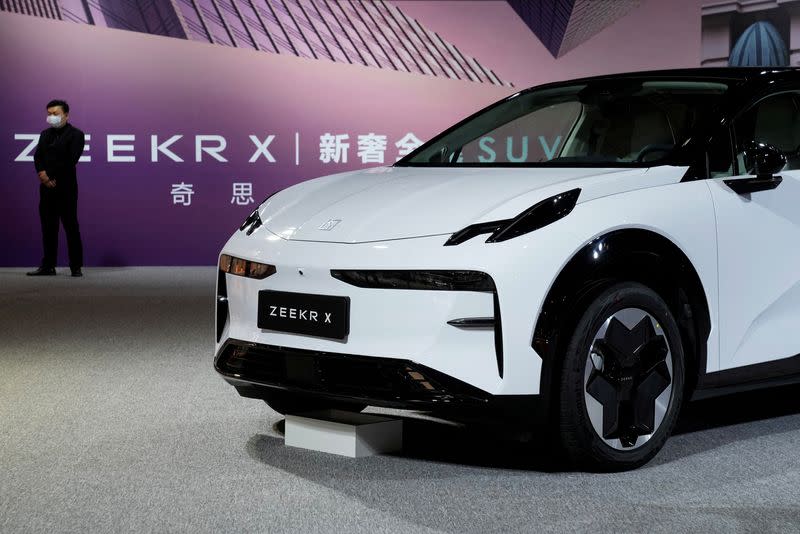Geely's EV brand Zeekr jumps on the 'gigapress' bandwagon
By Norihiko Shirouzu
(Reuters) - Geely's EV brand Zeekr is the latest to join a growing list of automakers that have turned to the "gigapress" die casting technique pioneered by Tesla to slash the cost of electric cars.
Zeekr's manufacturing technology chief Jiang Kehong told Reuters the Chinese carmaker had started using massive aluminium die casts to make a large rear underbody section of its Zeekr 009 six-seat, multi-purpose van (MPV).
He said the technique had helped Zeekr eliminate almost 800 welding points, cut defects, made the car lighter, and boosted its structural stiffness, in turn improving the ride of the MPV which went on sale in China this year.
"In the future, Zeekr will use giga-casting technology on more models," Jiang said.
Zeekr's shift to the gigapress technique comes at the same time Chinese rival Xpeng has adopted a new vehicle platform technology that also mimics the way Tesla designs and manufactures electric cars.
Metal and plastic die casting has long been used in manufacturing, but its application to large aluminium underbodies in carmaking is relatively new.
The newest and biggest press made by IDRA has a clamping force of over 9,000 tons. It can punch out the front and rear underbodies which support the car's outer skin and provide a platform for suspension components.
The front and rear sections are then connected with large under-floor battery packs to form a three-piece EV chassis.
The use of the heavy casting machines, dubbed "gigapresses" by Tesla, has helped simplify manufacturing and cut costs by up to 40% in some areas, according to Riccardo Ferrario, general manager of IDRA, based in Brescia near Milan.
'MEGA-CASTING'
Other automakers turning to large die casting include General Motors, which is using the technology to help design its Cadillac Celestiq electric saloon.
Individuals close to Toyota have told Reuters the Japanese automaker is considering the possibility of deploying a version of the giga-casting technology to produce EVs.
Sweden's Volvo Cars, meanwhile, which is majority-owned by Zeekr's parent Geely, announced a plan last year to invest in new EV manufacturing know-how, including "mega-casting" at its assembly plant in Torslanda, Sweden.
According to Zeekr's Jiang, the automaker started looking into the technology in 2020 and gets its giant presses from LK, the Chinese company that bought IDRA in 2008.
He said Zeekr's machines have a pressing power of 7,200 tons and they help pump out the 009's large underbody section, which is 1.4 m long and 1.6 m wide.
One risk in using giga-casting is the so-called repairability of vehicles. With body sections cast into single pieces, that could make them harder to repair if damaged in an accident — even a low-speed fender-bender or rear-end crash.
With most cars that might call only for the replacement of a fender or a bumper. In the case of a giga-cast vehicle it could entail a significant repair, including a possible replacement of the car's entire front or rear section.
GIGA-CONCERNS
Because of those concerns, some automakers such as GM are looking to embrace what engineers describe as smaller-scale giga-castings.
In designing the Cadillac Celestiq's underbody frame, GM is using what it describes as "mega precision sand casting" technology, which has cost and design flexibility advantages in low-volume applications, GM officials said.
The GM car's entire lower structure combines six fairly large castings including front and rear structures connected to two 8 ft long (2.5 m) castings, which are adhesively bonded and spot-welded into a single floor pan.
"While we are preparing a complete service plan for the Celestiq, at this point we plan to continue to be able to repair castings using our current proven repair procedures used on the Corvette," a GM spokesperson said, referring to another GM car that uses large castings.
Similarly, Toyota has begun looking at the possibility of turning to what some company insiders call "small portions" giga-casting technology which divides vehicle bodies into smaller castings, a Toyota source said.
The strategy is to address not only concerns about vehicle repairability but to cope with a wider range of vehicles in size and shape that Toyota sells globally, the person said.
To cope with the repairability issue, Zeekr will be able to change select parts of the larger die cast section in the event of a collision, rather than having to replace the whole thing.
"That should help reduce the repair cost after an accident,” the Zeekr executive said. "We believe customers should not pay extra for our technology innovation."
(Reporting by Norihiko Shirouzu; Editing by David Clarke)

 Yahoo Finance
Yahoo Finance 

